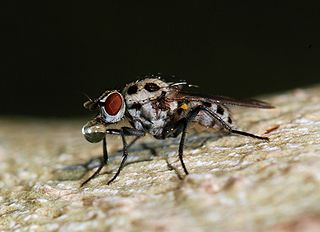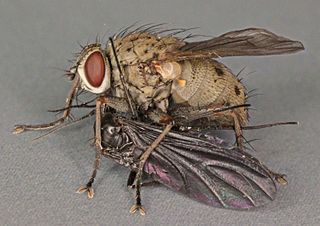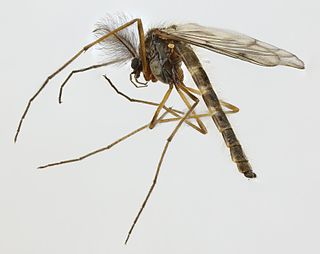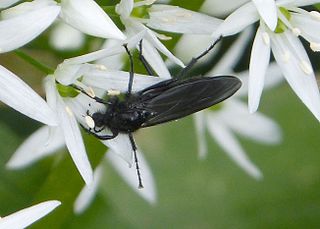
Anthomyia is a genus of flies in the family Anthomyiidae. They look rather like small houseflies, but commonly have conspicuous black-and-white patterning. This appears to be a mild form of aposematic coloration, though they do not appear to be distasteful unless they have eaten something offensive to the predator and have loaded their guts with it.

Rhamphomyia flava is a species of dance flies, in the fly family Empididae. It is found in most of Europe, except the Iberian Peninsula and most of the Balkan Peninsula.

Bara is a village in Rupnagar District in Punjab, India. The village has mainly two Jatt Sikh surnames Chakkal and Heer and lies on the Rupnagar-Morinda Road at the left bank of a seasonal monsoon rivulet called Budki Nadi, about four kilometers south-west of the city Ropar and 40 km (25 mi) northeast of Chandigarh on National Highway 205 (India) (NH-205). Bara is the site of significant archeological excavations connected with the Indus Valley Civilization. It has some evidence of being home to a culture that was a pre-Harappan strand of the Indus Valley Civilization. Baran and Harappan cultures may have intertwined and coexisted in some places, such as Kotla Nihang Khan, also in modern-day Punjab.

Sylvicola fenestralis, the window gnat, is a medium gnat (6–10 mm) of the family Anisopodidae. It is found in the Palearctic.

Limosina silvatica is a species of fly in the family Sphaeroceridae, the lesser dung flies. It is found in the Palearctic. The larvae live in a wide range of moist decaying organic materials where they feed on micro-organisms.

Chaoborus flavicans is a species of fly in the family Chaoboridae. It is found in the Palearctic.

Chironomus anthracinus is a species of fly in the family Chironomidae. It is found in the Palearctic.

Coenosia tigrina is a species of fly in the family Muscidae. It is found in the Palearctic.

Ornithomya avicularia is a species of fly in the family Hippoboscidae. It is found in the Palearctic.

Empis verralli is a species of fly in the family Empididae. It is included in the subgenus Anacrostichus. It is found in the Palearctic.

Glyptotendipes pallens is a species of fly in the family Chironomidae. It is found in the Palearctic.

Macropelopia nebulosa is a species of fly in the family Chironomidae. It is found in the Palearctic.

Phaenopsectra flavipes is a species of fly in the family Chironomidae. It is found in the Palearctic.

Prodiamesa olivacea is a species of fly in the family Chironomidae. It is found in the Palearctic.

Sapromyza quadripunctata is a species of fly in the family Lauxaniidae. It is found in the Palearctic.

Nephrotoma flavescens is a species of fly in the family Tipulidae. It is found in the Palearctic.

Dilophus febrilis is a species of feverfly the family Bibionidae. It is found in the Palearctic.

Cricotopus bicinctus is a species of fly in the family Chironomidae. It is found in the Palearctic.

Ptychoptera contaminata is a species of fly in the family Ptychopteridae. It is found in the Palearctic.
Anthomyia cannabina is a species of fly in the family Anthomyiidae. It is found in the Palearctic. Identification of Anthomyia cannabina is described in Bei-Bienko & Steyskal 1988.



















